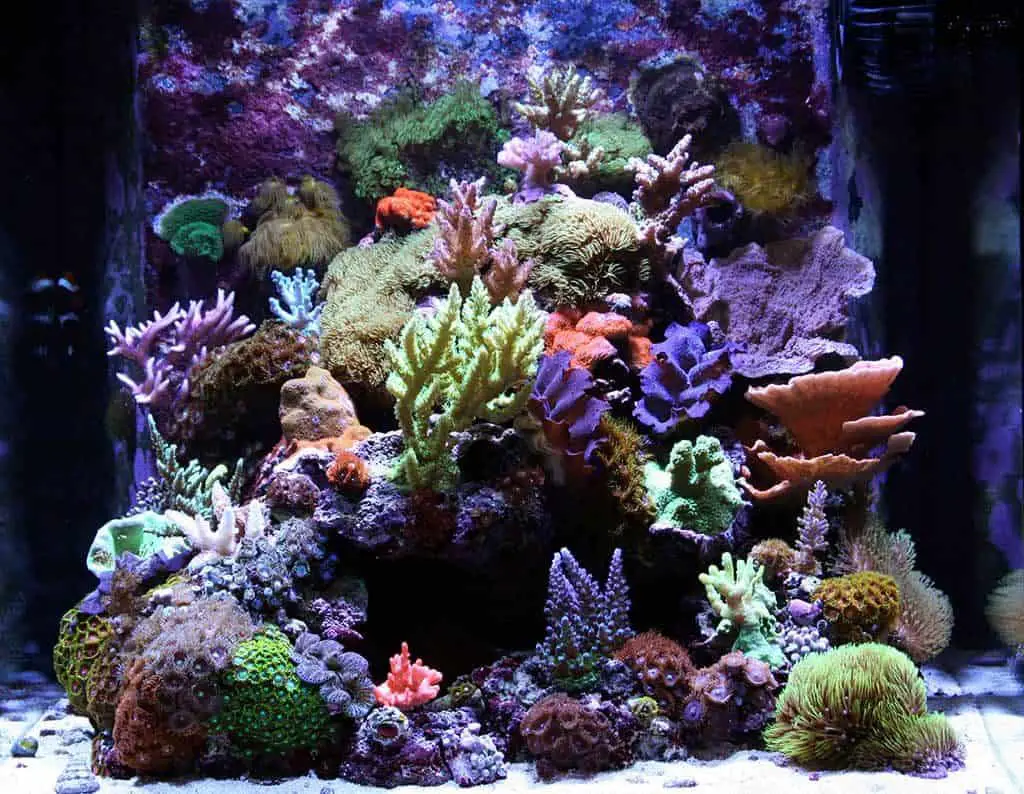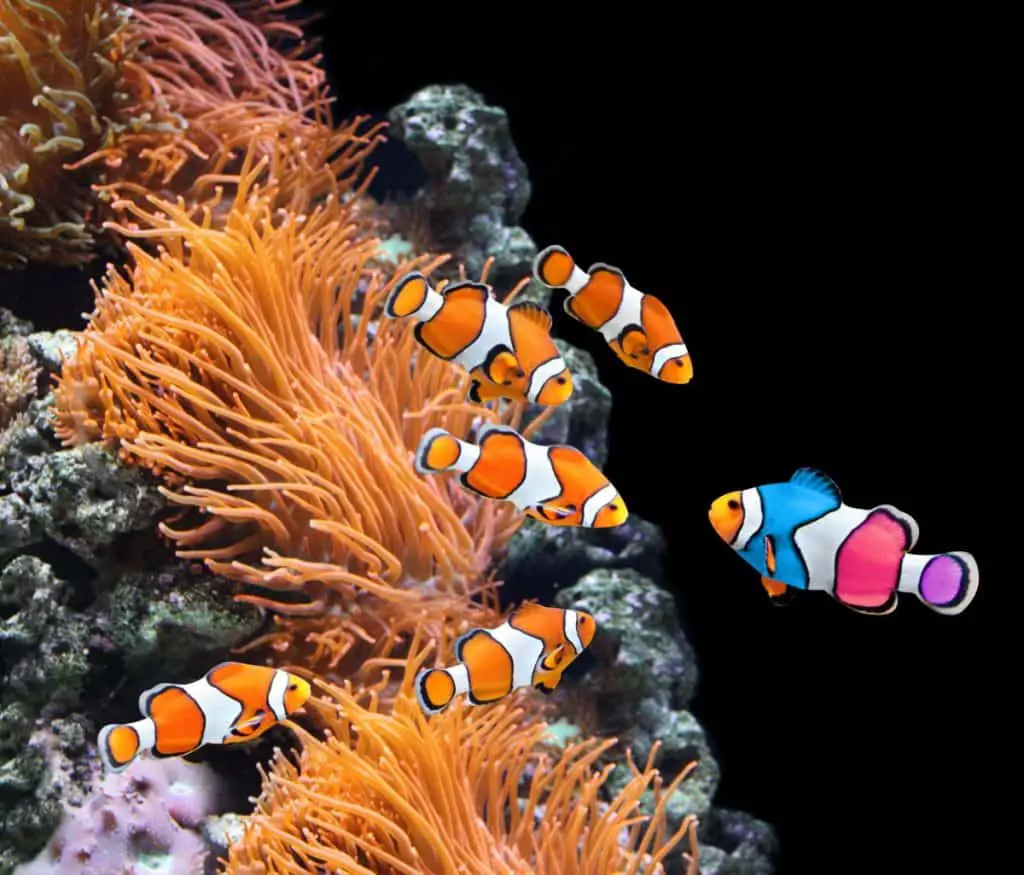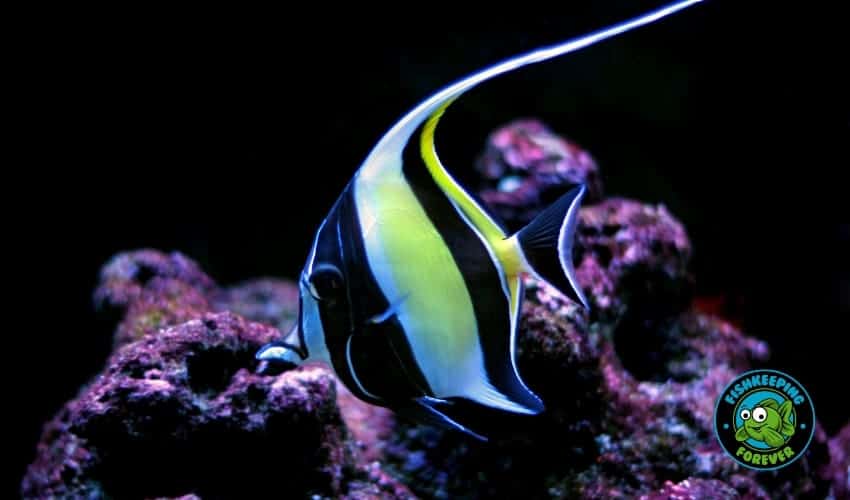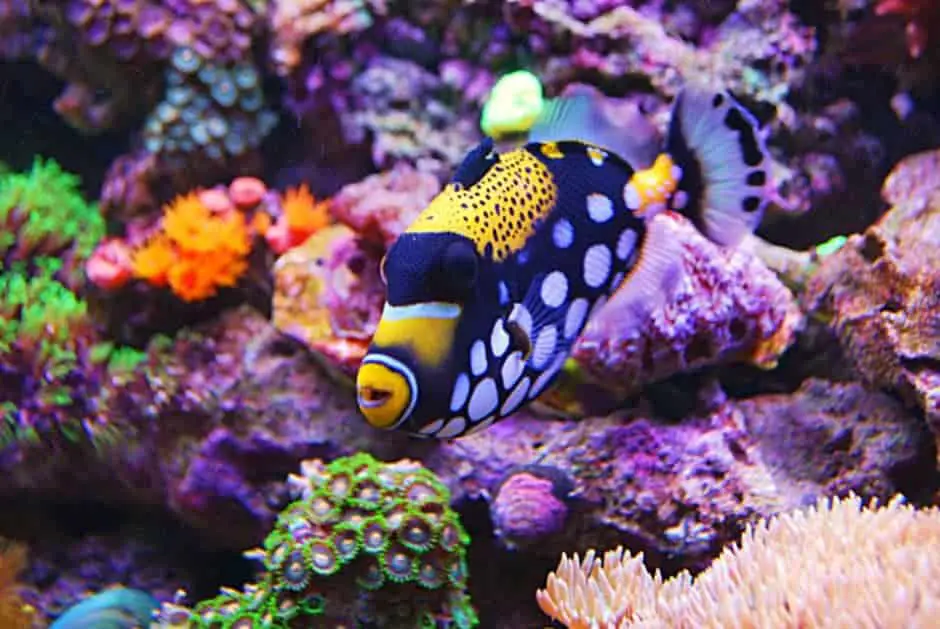If you are considering setting up your own saltwater aquarium, you are probably wondering how much this sort of arrangement can cost to maintain. With saltwater systems there will be an initial outlay to get up and running, and then also ongoing costs. The costs will vary based on a number of factors, which we will discuss in this article.
What does a saltwater aquarium cost to maintain? There are many factors that can affect the cost per year to maintain a saltwater aquarium. Going on the average size of a saltwater aquarium in most peoples homes the cost ranges from 0-0. This includes salt for water changes, foods, medication, electricity and even RO-DI water.

Table of Contents
What Does a Saltwater Aquarium Cost to Maintain?
Having a saltwater aquarium in your home or office provides not only a gorgeous décor feature, but your interaction with the community of fish brings calm and serenity as well.
If you are considering setting up your own saltwater aquarium, you are probably wondering how much this sort of arrangement can cost to maintain.
With saltwater systems, there will be an initial outlay to get up and running, and then also ongoing costs. The costs will vary based on a number of factors, most notably:
- How big your saltwater aquarium is
- The quality of products that you buy
- Your patience and care with your fish
- How exotic, fussy and moody your fish are (I’ll explain this a bit later)
Planning Ahead is the Best Way to Save Money
To ensure a successful saltwater tank set up before you even begin you need to plan ahead. Research the type of aquarium you want to have and make sure that you source good quality products and fish.
If you cut corners in the beginning and buy substandard items like a filter or heat lamp then these are more likely to break down, costing you more money in the long term.
If you don’t thoroughly research the size and type of aquarium you want beforehand then you might find a few months in that you want to change things around.
It is harder and more costly to make changes after your community is established (for example if you decide that you want a larger tank after all), so it is far better to pre-plan.
Fish look fine in small tanks and aquariums in the shops, but need more space than you think to thrive. Fish will comfortably grow to their full, healthy size when given a large enough environment to live in.
Read our article on how long it take for fish to grow to their full size. I have included a link above to the article for you.
If you give them less than what they need they won’t live as long and can develop conditions that limit their ability to swim.

If you put two or more incompatible fish in a small space, they will attack each other.
Reef tanks are smaller but more difficult to keep
Nano reef tanks are small specialist aquarium in which you keep a very selective amount of corals and small fish. Usually a couple of fish and some invertebrates.
These aquariums are not for the beginner due to the small amount of water within the aquarium being very difficult to maintain the water qualities.
Read our article on the Best Nano Reef Fish.
Aquariums with larger amounts of water are easier to balance and maintain the correct water chemistry.
Clownfish are a popular fish for smaller aquariums.
Don’t cut corners!
If you cut corners in the care of your fish or their environment, such as sourcing the wrong substrate or not giving your live coral enough time to establish itself before adding fish, then you could be making costly mistakes.
With a saltwater aquarium, there isn’t really a cheap way to do it.
The most cost-effective way is to spend the money on reputable products, food, and fish, and put in the time that your community need to take care of them properly.
The most expensive way to do it is to try to run it on the cheap or without proper care and time.
A saltwater aquarium gone wrong can be a very costly exercise indeed. So, the best way to save money is to research properly before you start.
Time and Care
A saltwater aquarium needs to be maintained at the optimum levels for its inhabitants. This means keeping an eye on temperature, pH levels, salt levels and the cleanliness of the tank.
The more regularly you check these levels and clean the tank and change the water, the healthier your fish will be.
So, putting in extra care and attention will take up more of your time, but will in the long run, save you money. It will also provide a more interactive and rewarding fish-keeping experience.
Even the type of water you use should be considered. Many salwater and marine aquarists insist on using only the best quality water which is called RO-DI water. This can be purchased from your local fish store or pet store.
You can also make RO-DI water buy running your own tap water through a Reverse Osmosis and deionization machine.
This will remove all traces of harmful metals and other chemicals not suited to saltwater aquariums.
Read our article on this topic here. It could save you time and money.
Specialist Fish Breeds
Saltwater fish can be categorised into those that are reef safe and those that aren’t. Reef safe means they get along well with other fish and are less inclined to attack them or eat them.
Reef safe fish tend to be less fussy in their diets and usually cheaper to feed because they will be happy with more generic dried food mixes.
You can also go with a one size fits all reef food and please everybody in this tank.

If you want to learn more about the different costs of specific fish, check out our article here.
Specialist, high end or marine saltwater fish are more expensive than reef fish, for a few reasons:
- They are rarer to buy and cost more to purchase
- They often require larger tanks and more personal space
- They have specialist diets requiring you to source specific food.
With saltwater fish, depending on the breed, they can be temperamental and will need the right amount of personal space to be happy. You don’t want to overcrowd a tank or buy a tank that is small if you like to own some larger breeds of fish.
Read our interesting and fun article: 21 Ways to make your fish happy.
The rarer your saltwater fish breeds, the more expensive they will be to source, as well as to feed.
Plus, if you choose rare and expensive fish then you probably want to invest in a good-quality tank, heater and filtration system.
Do you know the most expensive saltwater fish can cost over $35,000 each. WOW
Yeah 35k per fish is out of my league. Thankfully there are some amazing fish that cost less than $30 each. Here’s a list of some popular saltwater fish prices.
Entry level fish costs
| Names | Prices Juvenile | Prices Adult |
|---|---|---|
| Clownfish | $10 | $120 |
| Yellowtail Damsels | $5 | $15 |
| Blenny | $15 | $40 |
| Green Chromis | $15 | $40 |
| Cardinal Fish | $15 | $40 |
| Jawfish | $20 | $120 |
| Wrasse | $20 | $120 |
| Rabbit Fish | $30 | $100 |
| Dwarf Angelfish | $40 | $90 |
Intermediate level fish costs
| Name | Price Juvenile | Price Adult |
|---|---|---|
| Lionfish | $49.99 | $200 |
| Basslets | $20 | $80 |
| Yellow Tang | $40 | $90 |
| Blue Tang | $49 | $150 |
| Banded Pipefish | $30 | $90 |
| Leaf Fish | $40 | $100 |
| Tassel Fishfish | $60 | $120 |
| Snowflake Eel | $50 | $200 |
| Dragonet Mandarins | $40 | $70 |
Expert level fish costs
| Names | Prices Juvenile | Prices Adult |
|---|---|---|
| Blue Spotted Stingrays | $200 | $1500-2000 |
| Clown Triggerfish | $120 | $800 |
| Blueline Grouper | $150 | $400 |
| Moorish Idol | $120 | $300 |
| Batfish | $120 | $700 |
| Dog Face Puffer | $150 | $800 |
| Cat Shark | $120 | $600 |
| Emperor Angelfish | $150 | $1000 |
| Copperband Butterfly | $50 | $180 |
Considerations About Aquarium Size
The biggest contributing factor to the cost of your aquarium is its size. The smallest tank you could run and have thriving fish should be no less than 60 litres.
You can then source tanks in all shapes and sizes, with larger commercial ones holding as much as 2000 litres.
You can buy off the shelf tank shapes and sizes up to around 1000 litres, and then beyond that, you would probably need to get one especially made.
Tanks below 100 litres you may be able to get away with keeping on a solid table or chest of drawers, so you may not need to purchase a special stand as well.
Once you get over 100 litres you will need to purchase a special stand as well as the tank.

Remember to factor the gravel and rocks that you add to your tank into your weight calculations.
Here’s a great tool to work out the weight of your aquarium. Fish Tank Calculator.
You will need a big enough tank for the size of fish you would like to keep, remembering that some can grow quite big, and many of them like a lot of space to move around or hide. Some of them also prefer to be quite solitary and keep to themselves.
Saltwater has less oxygen within in than freshwater, so you need a bigger tank than you would with freshwater fish, basically so your little guys can breathe.
You will need a strong enough stand for the tank and all of the water – it is best to buy both together or discuss with your supplier which stand would be best for your tank.
Saltwater Aquarium Start-Up Costs
You will need:
- Aquarium
- Stand
- Substrate for the base
- Saltwater mix (you can’t just add table salt to water)
- Live rock
- Water filter
- Powerhead
- Lighting
- Water testing kit
- Ammonia and other chemicals to maintain the balance of the water
If you are going to keep more than one fish in your aquarium, you will also need a smaller tank which is your hospital/quarantine tank. Newly acquired fish need to go into this for a little while before introducing them to the rest of the community.
In terms of cost, you can set up a perfectly good saltwater system relatively cheaply, but it will be smaller and hold less fish, and only suitable for the hardier or reef friendly breeds.
Generally, you would pay at least $500-$700 for all of the equipment you need for a small (60L) saltwater system. On top of this you will need fish, and to supply the right food for them.
| Item | Cost |
| Start Up | |
| Aquarium (60L) | $100 |
| Stand | $85 |
| Substrate, Live Rock and Décor | $250 |
| Water Filter, Light and Heater | $150 |
| Water Testing Kit | $15 |
| Quarantine Tank set up | $100 |
| Other equipment (Net, Algae Scraper, Thermometer, Siphon) | $20 |
| Maintenance | Cost per year |
| Specialist Food | $250 |
| Basic Food | $50 |
| Saltwater Mix | $100 |
| Filter Cartridges | $50 |
| Water Chemicals and Testing | $80 |
| Medication | $20 |
| Replacement Bulbs | $20 |
Long Term and Ongoing Costs for a Saltwater Tank
A saltwater tank system, as well as the fish you will buy to populate it, are both more expensive than freshwater systems. You will need to pay for salt as well as water testing items regularly.
You will also need a supply of cleaning products for your tank which are specialised, and can’t be swapped for general household ones.

Saltwater systems need to be properly monitored to make sure that the balance of salt and other chemicals in the water are fine for your fish, as well as maintaining the warm temperature that tropical fish will thrive in.
Your main ongoing costs for looking after a saltwater tank are the food, saltwater mix, chemicals and cleaning products and cost of electricity at home to keep it running.
It depends on your energy provider, but roughly it costs around the following amounts to run a saltwater tank:
| 160L | $168 annual electricity spend |
| 220L | $225 annual electricity spend |
| 450L | $450 annual electricity spend |
| 1000L | $1000 annual electricity spend |
Saltwater fish can be quite specific in their diets, so this cost is probably the most expensive one to maintain, depending, as always, on the fish breeds that you choose to keep. Some need fresh or frozen meat such as shrimp, worms, and scallops, as well as vegetable sources such as seaweed, whereas others will be happy with pellets or flakes.
Here’s a great tool to calculate the power/electricity cost of your aquarium.
Your ongoing maintenance costs for a small and basic saltwater tank system will be around $400 annually, increasing to at least $600 annually if you need specialist food.
Things to Consider when looking after a Saltwater System
You need to allow at least a month when you first set up your saltwater tank before you add any fish. This allows the rock and plants to get established and the water levels to adjust to a healthy level for your fish.
We use atlantic coral rocks for our backdrop in most of our aquariums. They soon change color and start growing algae on them in no time with the correct lights.
We use LED lights in all our saltwater aquariums. We have reviewed the best recently. Here’s our LED Aquarium Light Review.
A saltwater tank must be monitored daily to make sure that the salt levels of the water are balanced. Because, in the wild, their environment is fairly stable in terms of temperature, pH level, salinity, etc., these kinds of fish are used to constant conditions.
Saltwater tanks grow algae quite quickly, because they have fewer living plants in them than freshwater tanks (living plants help to slow down the algae build-up). You will need to clean a saltwater tank more often to keep on top of the algae and keep your fish happy and healthy.
Macro Algae is a great way to help maintain your aquariums water quality and also decorate your aquarium to make it look like an underwater garden. We have an article here for you on macro algae.
Cost to Maintain Saltwater Aquarium
To help you get a good idea of what you are in for, I will break the costs down into the start-up, weekly, monthly and yearly costs of a number of different sized systems.
Fish are not included in the following cost summaries, but I have included food and electricity costs.
| Type of Aquarium | Costs | |||
| Start-Up | Weekly | Monthly | Yearly | |
| Small Reef Tank (60-80L) | $700-$800 | $11-$12 | $45-$50 | $500-$600 |
| Small Specialist Tank (60-80L) | $700-$800 | $15-$18 | $60-$70 | $700-$800 |
| Medium Reef Tank (100-200L) | $1700-$2000 | $15-$18 | $60-$70 | $700-$800 |
| Medium Specialist Tank (100-200L) | $1700-$2000 | $22-$30 | $90-$120 | $1100-$1400 |
| Large Reef Tank (500-1000L) | $3000-$10,000 | $35-$55 | $125-$150 | $1500-$1800 |
| Large Specialist Tank (500-1000L) | $3000-$10,000 | $40-$50 | $170-$210 | $2000-$2500 |
Final Thoughts: Cost to maintain saltwater aquariums
I absolutely love a saltwater aquarium when it is well looked after. The fish and live coral will thrive, giving you a showpiece of vibrant colour and activity every day.
Like any pet, having fish will cost you a bit in terms of start-up and maintenance. You can’t buy and care for a living creature without having incurring ongoing costs for this.
The best way to save money is to do your research properly beforehand to make sure that you get the right fish and the right environment for them.
If you try to cut corners in the setup or in looking after your fish, then you may cost yourself more in fixing these mistakes.
Putting in more time and preparation will save you money, and happy healthy fish will make it all worth it
Related Content
- What is the average cost of buying a fish?
- Average cost of the perfect fish tank for toddlers
- Filter cost for small aquariums
- Filter cost for large aquariums
- Fish food costs

I have been working in the tropical fish industry for over 30 years now and I’m still learning. Everyday is a school day in this hobby. In my spare time I play golf very badly!



